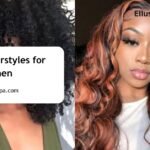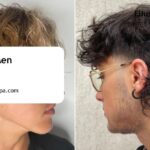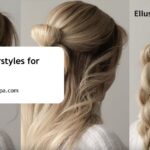The beehive hairstyle isn’t just a relic of the 1960s—it’s an iconic look that continues to make waves in fashion circles today. With its distinctive cone-shaped silhouette and impressive height, this dramatic updo has adorned the heads of countless celebrities and style icons from Audrey Hepburn to Amy Winehouse.
We’ve seen the beehive evolve from its classic form to modern interpretations that blend vintage charm with contemporary flair. Whether you’re looking to make a bold statement at a special event or simply want to experiment with a retro-inspired look, the beehive offers versatility that few other hairstyles can match. In this guide, we’ll explore everything you need to know about creating, styling, and rocking this timeless coiffure that stands tall in hair history.
The History of the Iconic Beehive Hairstyle
The beehive hairstyle first emerged in 1960 when Chicago-based hairstylist Margaret Vinci Heldt created this towering style in response to a challenge from Modern Beauty Salon magazine. Editors had asked Heldt to design something fresh and exciting for the new decade, dramatically different from the flat, lacquered styles of the 1950s. Her inspiration came from a black velvet fez-style hat with decorative bees, which eventually gave the hairstyle its recognizable name.
By 1961, the beehive had taken America by storm, quickly becoming the hairstyle of choice for sophisticated women across the country. Female celebrities like Audrey Hepburn, Aretha Franklin, and Dusty Springfield embraced the voluminous updo, catapulting it into mainstream popularity. The style’s association with elegance and refinement made it particularly popular for formal events and among the upper class.
During the mid-1960s, the beehive reached its peak popularity, often combined with other popular styles like flipped ends or bouffant variations. Women would visit salons weekly just for maintenance, as preserving the elaborate structure required important effort and hairspray. Many devoted beehive wearers even developed the habit of sleeping with their necks on special pillows to maintain their carefully crafted heights between salon visits.
The political and cultural shifts of the late 1960s temporarily diminished the beehive’s popularity as more natural, flowing hairstyles aligned with the hippie movement took center stage. After its initial heyday, the style experienced recurring revivals throughout subsequent decades. The B-52’s, an American new wave band formed in 1976, featured female members sporting exaggerated beehives, helping reintroduce the style to younger generations.
Throughout the 1980s and 1990s, modified versions of the beehive appeared in fashion magazines and on runways, often with punk or grunge influences. The early 2000s saw a important resurgence when Amy Winehouse adopted her signature oversized beehive, making it her trademark look and inspiring countless women to experiment with the retro style. Fashion designers and celebrities continue drawing inspiration from this enduring hairstyle, ensuring its place in contemporary beauty culture.
10 Classic Beehive Hairstyles That Never Go Out of Style
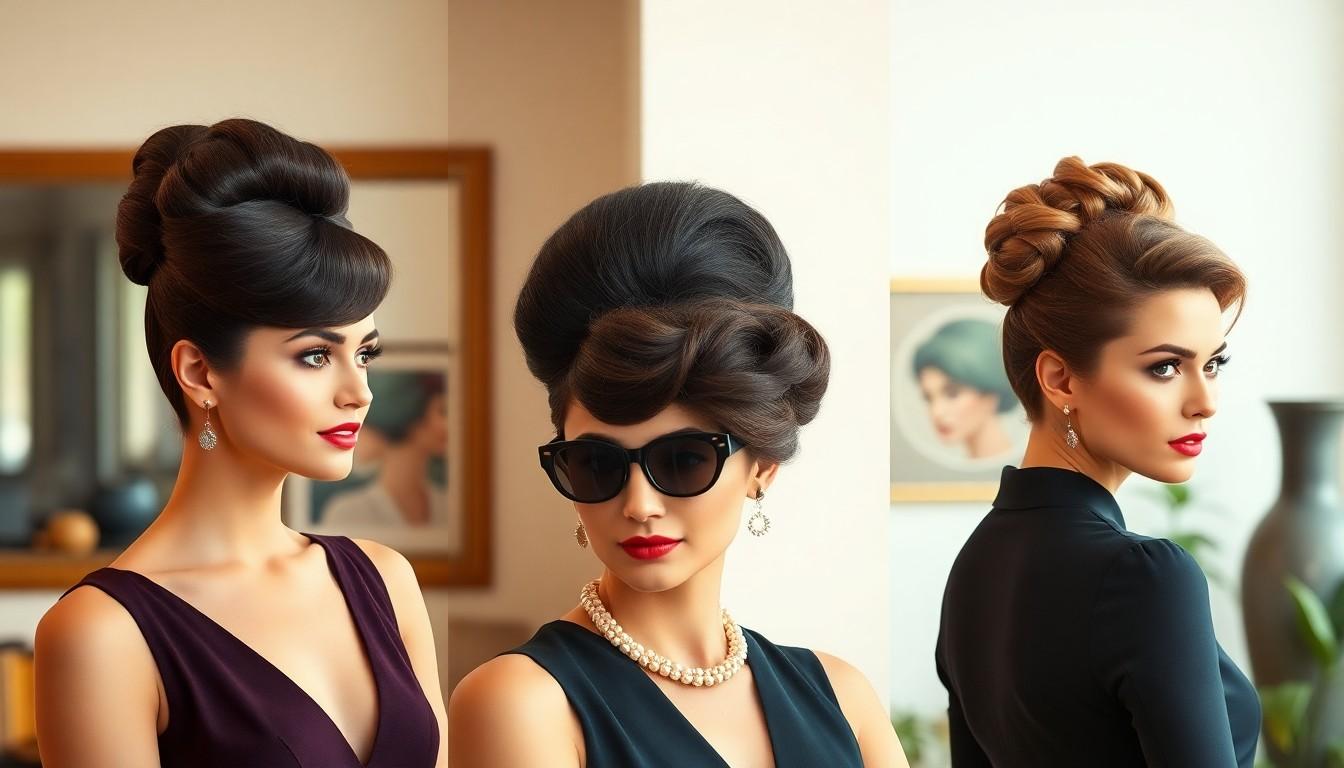
The Traditional 1960s Beehive
The traditional 1960s beehive features long hair meticulously piled into a distinctive conical shape on top of the head, pointing slightly backward. Backcombing or teasing the hair creates the characteristic tangled foundation, which is then lightly combed over to achieve that smooth, polished outer surface. This iconic style stands apart from bouffant hairstyles through its rounded cone shape, though they often shared similarities during the era. Chicago celebrity hairstylist Margaret Vinci Heldt deserves credit for popularizing this style, designing it specifically to fit under a fez and even adorning it with a bee-shaped hatpin. Aerosol hairspray, which became widely available in 1948, proved essential for maintaining the impressive height and structured shape that defines the classic beehive.
The Modern Half-Up Beehive
The modern half-up beehive offers a contemporary twist on the classic style by only styling the top section of hair in the traditional beehive manner. Backcombing and teasing focus on the crown area to create impressive volume, while the lower sections remain loose for a more relaxed, versatile appearance. This updated interpretation brilliantly combines the vintage volume of the traditional beehive with modern styling sensibilities that work for today’s fashion industry. Finishing this style requires minimal hairspray application, ensuring the hair maintains a touchable quality while still preserving the controlled height that makes it recognizably a beehive.
The Formal Beehive Updo
Formal beehive updos transform the classic style into elegant options perfect for special occasions and formal events. Achieving this sophisticated look involves backcombing to create the signature cone shape, then securing everything in place with strategic pinning and styling products for longevity. The outer layer of this formal variation typically features a sleek, smooth finish that exudes polish and refinement. Red carpet events, weddings, and other formal gatherings frequently showcase this timeless updo, demonstrating its enduring appeal for occasions that demand elegance.
The Casual Beehive Ponytail
The casual beehive ponytail combines classic volume with everyday wearability for a look that’s both stylish and practical. Backcombing at the crown creates the signature bouffant effect, while the remaining hair sweeps back into a voluminous ponytail secured at mid-crown level. This relaxed interpretation works perfectly for daily wear or casual outings when you want elevated style without full formal commitment. Applying a gentle pomade to finished styles adds texture and hold while maintaining the more laid-back vibe that characterizes this versatile beehive variation.
Celebrity-Inspired Beehive Hairstyles Through the Decades
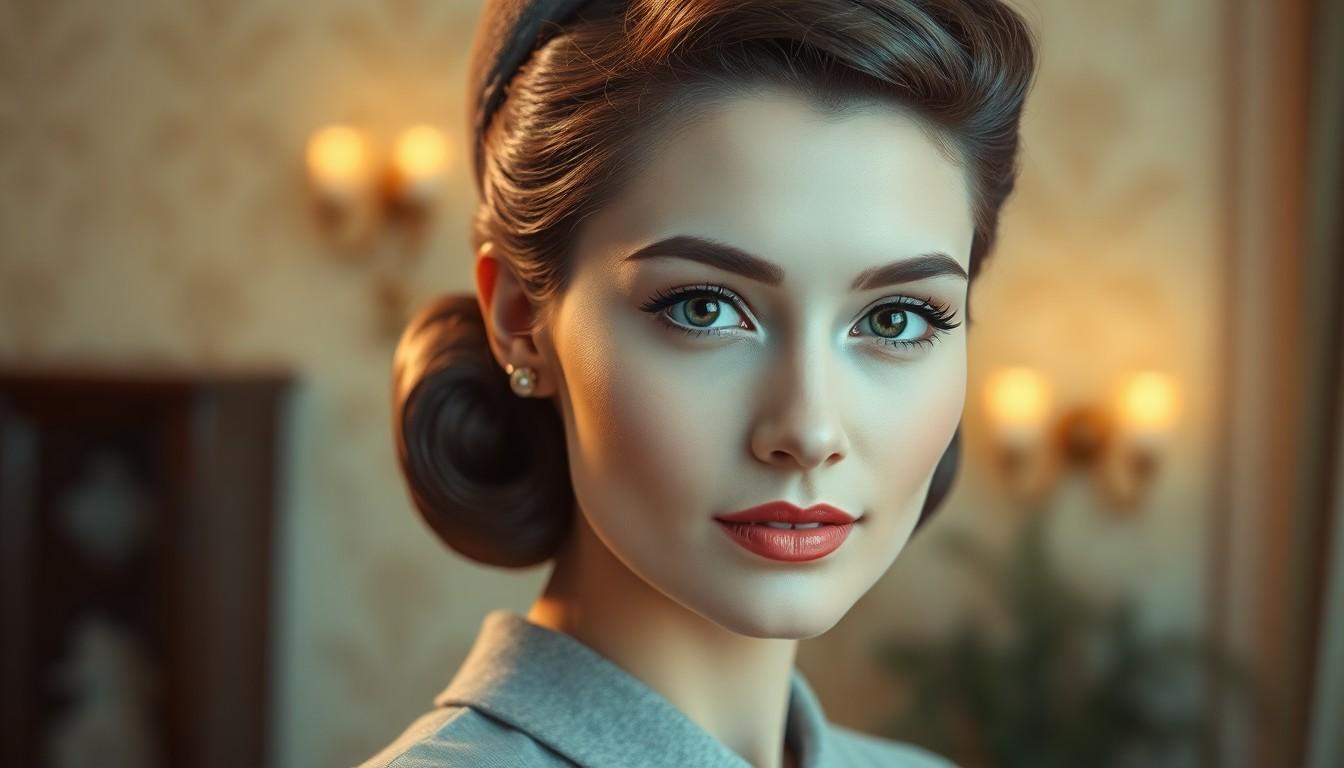
Throughout fashion history, iconic celebrities have put their unique stamp on the classic beehive. These famous interpretations have inspired generations and shaped how we view this enduring hairstyle.
Audrey Hepburn’s Elegant Beehive
Audrey Hepburn transformed the beehive into a symbol of timeless sophistication in the 1960s. Her interpretation featured a sleek, polished finish that complemented the fashionable pillbox hats of the era perfectly. “Breakfast at Tiffany’s” showcased her signature beehive style—smoothly pulled back from the forehead with a controlled, refined appearance. Fashion enthusiasts continue to emulate Hepburn’s elegant beehive for its classic charm and understated glamour that transcends generations.
Amy Winehouse’s Signature Beehive
Amy Winehouse revolutionized the beehive with her bold, exaggerated interpretation that became inseparable from her artistic identity. Her version featured dramatic volume and extensive backcombing, creating a statement look that honored retro aesthetics while adding contemporary edge. Winehouse’s beehive stood tall and commanding, often paired with her distinctive winged eyeliner to complete her instantly recognizable image. This modern reinterpretation helped reintroduce the beehive to new generations, cementing its status as more than just a vintage style.
Adele’s Red Carpet Beehive Moments
Adele has occasionally embraced the beehive for prestigious red carpet appearances, offering a subtler take on this classic hairstyle. Unlike Winehouse’s dramatic version, Adele’s beehives typically feature more natural volume and moderate height, making them accessible for contemporary formal events. Her approach modernizes the vintage style while maintaining its sophisticated essence, perfectly complementing her elegant fashion choices. Though less frequently documented than other celebrities’ beehives, Adele’s interpretations demonstrate how this iconic hairstyle can be adapted for today’s red carpet standards while honoring its historic roots.
How to Create the Perfect Beehive Hairstyle at Home
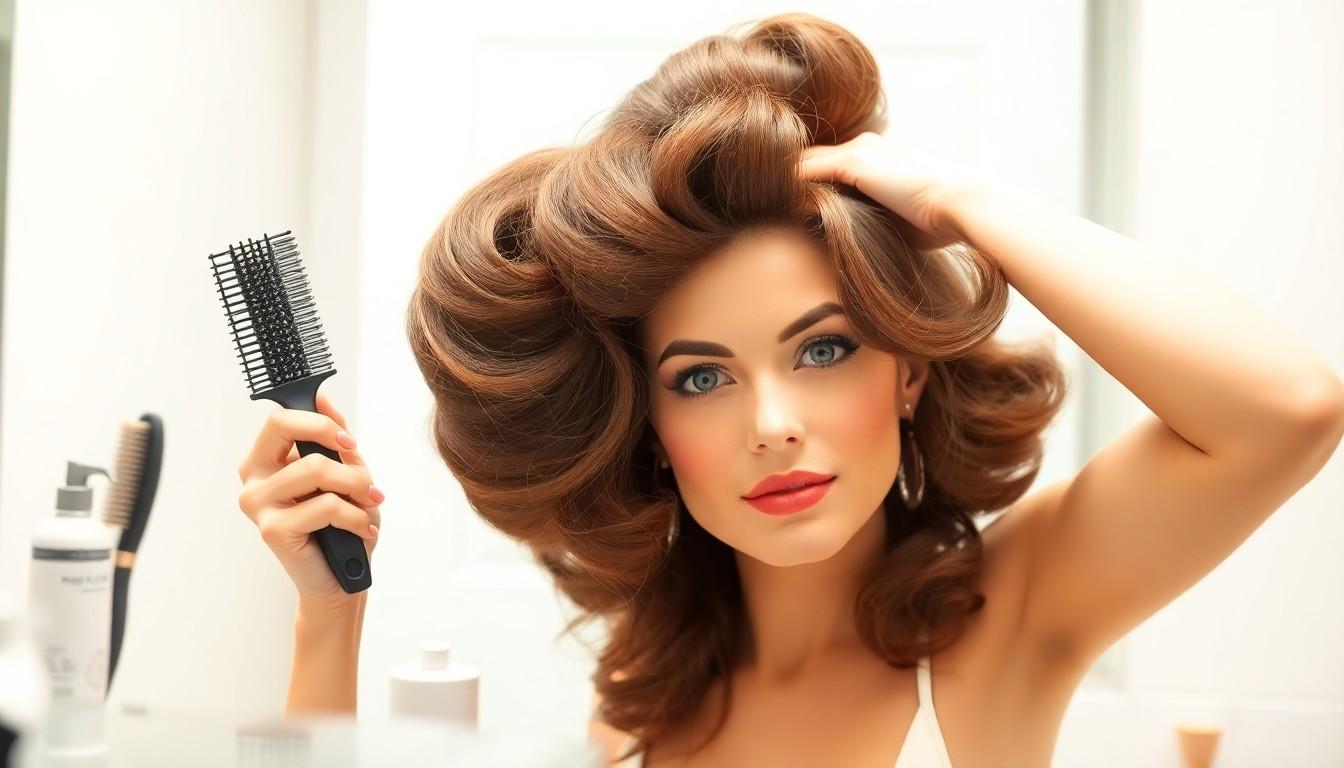
Creating a stunning beehive hairstyle doesn’t require a trip to the salon. With the right tools and techniques, you can achieve this iconic look right in your own bathroom.
Essential Tools and Products for Beehive Styling
- Teasing Brush: A quality teasing brush serves as the foundation for creating volume and structure in your beehive hairstyle.
- Bobby Pins: Plenty of sturdy bobby pins will secure your creation and ensure it stays in place throughout the day or evening.
- Hairspray: A strong-hold hairspray is absolutely essential for maintaining the shape and preventing flyaways in your beehive.
- Dry Shampoo: This miracle product adds texture and volume to the roots, making it easier to create the height needed for a proper beehive.
- Bath Loofa: For beginners or those wanting extra height, a bath loofa covered with fabric matching your hair color can provide structure.
- Fabric: Choose a fabric that matches your hair color to cover the loofa if you’re using this method for additional volume.
- Rubber Bands: These help section off your hair during the styling process, making the beehive creation more manageable.
Step-by-Step Beehive Tutorial for Beginners
- Prepare Your Hair: Start with clean, center-parted hair for the best results. Divide your hair into four sections: two from the top of the ears to the middle parting, and two horizontally across the back of the head.
- Add Volume: Take your teasing brush and thoroughly tease the under layers of your hair, leaving the top layer smooth and untouched. Teasing creates the necessary volume that gives the beehive its characteristic height.
- Create Structure: For a more defined bump, cover a bath loofa with fabric matching your hair color and place it where you want the bump to sit. Alternatively, achieve the same effect through extensive teasing at the crown area.
- Shape the Beehive: Pull pieces of hair from both sides back to cover the sides of your bump, creating a smooth and elegant shape. For a half-up half-down variation, direct hair to one side and tease around to form the desired shape.
- Secure Your Style: Use bobby pins strategically to secure the hair in place without making them visible. Smooth out the teased section with a gentle brush stroke to tame any frizz and create a polished appearance.
- Finish with Hairspray: Apply a generous amount of hairspray to hold your beehive in place, focusing especially on the teased sections that provide structure.
Troubleshooting Common Beehive Hairstyle Problems
- Insufficient Volume: When your beehive falls flat, ensure you’re teasing the under layers thoroughly enough. Apply dry shampoo at the roots before styling to create extra texture and lift.
- Exposed Loofa: If your structure is showing through, cover the loofa completely with additional hair and secure with more bobby pins. Make sure to check your style from all angles to ensure complete coverage.
- Frizzy Appearance: Combat unruly hair by smoothing the outer layer gently with a brush after teasing. Apply a light hair serum to the outer layer only to control flyaways without weighing down the style.
- Style Collapsing: When your beehive won’t stay up, use stronger hold hairspray and insert bobby pins in a crisscross pattern for maximum security. Consider teasing more aggressively at the base to provide a stronger foundation.
- Uneven Shape: Create symmetry by checking your beehive in multiple mirrors to see all angles. Adjust the shape by gently pushing with your fingers and securing with additional pins where needed.
Modernizing the Beehive: Contemporary Twists on a Vintage Style
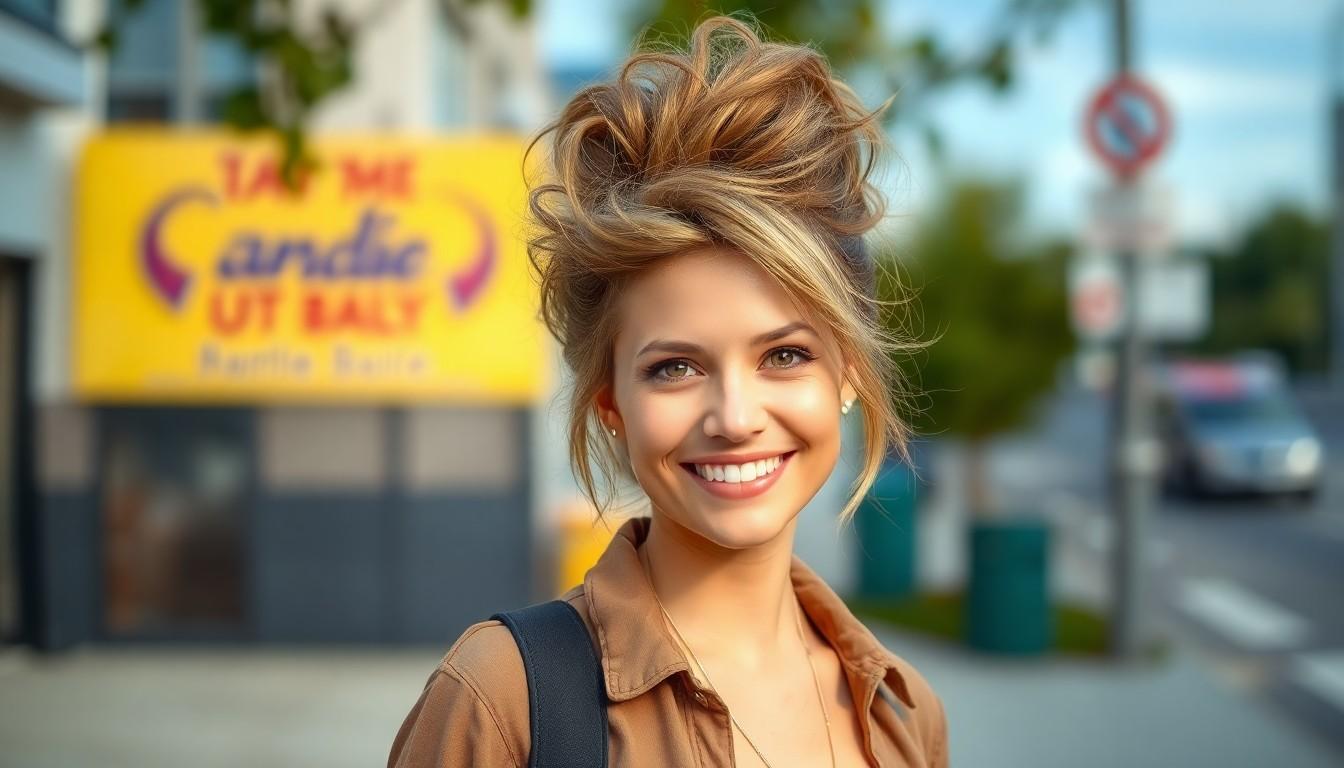
Today’s beehive hairstyle has evolved significantly from its 1960s origins, incorporating softer textures and more natural-looking volume. Unlike the traditional rigid, sky-high beehive, modern versions feature a looser, more relaxed appearance with less backcombing and more texture products like dry shampoo and texture powders. These contemporary interpretations maintain the iconic height at the crown while adding waved, ruffled finishes and softer strands framing the face for a fresh take on this classic style.
The Messy Beehive for Casual Occasions
The messy beehive offers a perfect everyday alternative to the formal updo, creating loose volume at the crown with minimal structure. This relaxed style intentionally incorporates imperfection with sporadically placed bobby pins and a lived-in texture that feels modern and effortless. Dramatic highlights or balayage complement this undone appearance beautifully, improving the dimensional quality of the style. Texture remains the key element in this variation, making it both easier to maintain and more appropriate for casual settings while still capturing the essence of the classic beehive.
Beehive Braids and Twists
Braided elements add exciting dimension to contemporary beehive styles, creating unique hybrid looks with edgy appeal. One striking variation features tightly braided sides twisted together to form the base of the upper section, which then transforms into a voluminous beehive while the lower half remains straight to emphasize the bouffant. Accessories like decorative headbands can elevate these styles further, adding a feminine touch while maintaining a fashion-forward edge. These combinations of techniques allow for creative expression while honoring the beehive’s structural foundation.
The Mini Beehive for Shorter Hair
Short-haired individuals can still embrace beehive styling through adapted mini versions that work beautifully with bob-length cuts. This modified approach creates height at the crown while incorporating flipped ends and wispy side bangs for a modern interpretation of the classic silhouette. Styling products become especially important for shorter variations, providing the hold and texture needed to achieve volume with less length. Retro-inspired mini beehives might require more careful styling to avoid looking costumey, but with thoughtful execution, they offer a stylish option that captures the essence of the iconic look while working with shorter hair lengths.
Matching Your Beehive Hairstyle to Different Occasions
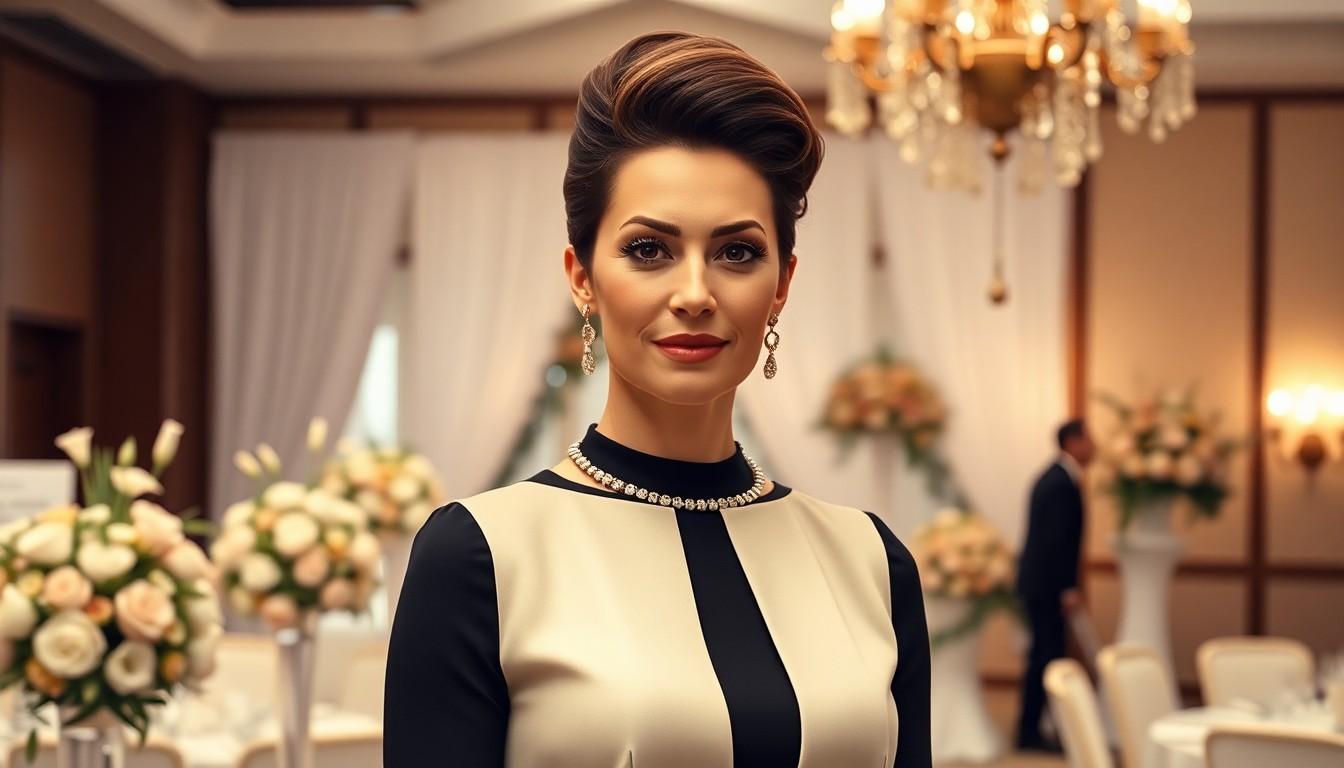
The versatile beehive can be adapted for any setting, from the most formal affairs to casual weekend outings. Let’s explore how to tailor this iconic style for various occasions.
Wedding and Formal Event Beehives
For special celebrations and formal gatherings, the beehive transforms into an elegant statement that exudes sophistication. The classic beehive stands as a timeless choice for weddings, characterized by its perfectly conical shape on top of the head. We recommend refining this traditional style with minimal teasing and applying a generous amount of hairspray to maintain its structured silhouette throughout lengthy events. This elegant interpretation evokes 1960s glamour while offering a polished look that complements formal attire.
Another stunning option is the textured layered beehive, featuring a flirty side-swept front and loose, messy ends while maintaining the signature height that defines the style. Creating this variation focuses on achieving touchable, controlled volume rather than rigid structure. Professional stylists suggest using less hairspray for this look, allowing for a softer finish that moves naturally when dancing at receptions or formal parties.
Office-Appropriate Beehive Variations
Workplace environments call for more subdued interpretations of the beehive that maintain professionalism while showcasing your style sensibility. The lower volume beehive offers an ideal solution, featuring a more modest height that adds sophistication without appearing overdone. Achieving this office-friendly look requires less teasing at the crown and lighter hold hairspray, creating a refined silhouette that commands respect in professional settings.
The headband beehive presents another excellent option for the workplace, as this accessory helps control volume while adding a polished element to the overall style. Incorporating a simple, elegant headband into your beehive helps maintain the retro aesthetic in a more restrained manner. This practical variation stays neat throughout the workday while still nodding to the classic beehive tradition.
Weekend Beehive Styles
Casual outings provide the perfect opportunity to experiment with playful, contemporary takes on the traditional beehive. The mid ponytail beehive combines the best of both worlds, featuring a voluminous bouffant at the crown that transitions into a full ponytail secured at the middle of the head. This versatile style works beautifully for shopping trips, brunches, or casual gatherings where you want to look put-together without appearing overly formal.
For those seeking to make a statement during weekend adventures, the colorful beehive infuses the classic silhouette with bold streaks or temporary color. Adding vibrant hues to your beehive instantly modernizes this retro style, making it perfect for music festivals, art exhibitions, or casual parties. Fashion-forward individuals embrace this creative interpretation as it allows personal expression while honoring the iconic shape that made the beehive famous.
How to Maintain Your Beehive Hairstyle All Day Long
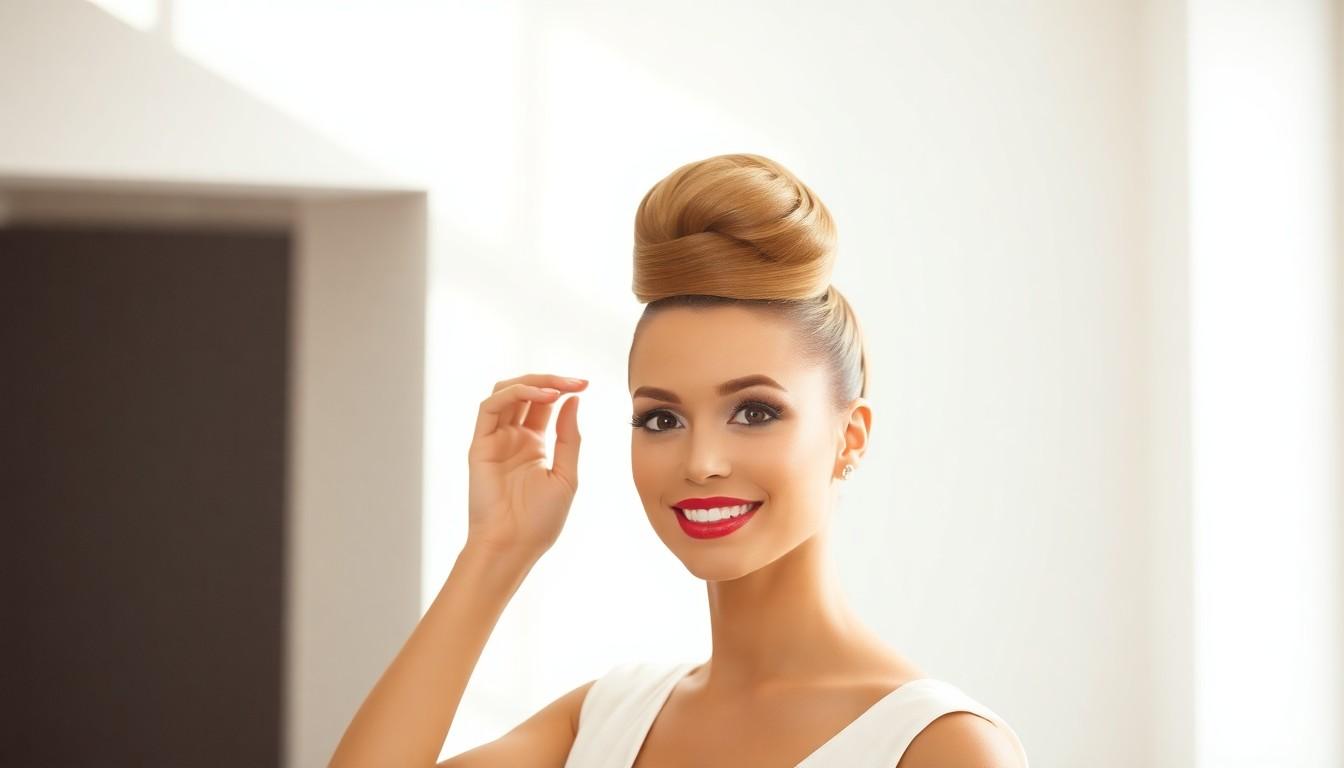
Volume and Teasing
Creating substantial volume at the roots is essential for a lasting beehive. We recommend applying a volume-improving mousse or tonic water to give your hair the necessary lift before styling. Backcombing your hair with a teasing comb, particularly in the middle section, builds the signature height that defines this iconic style. Focus on creating volume through layers of teased hair, working from the crown toward the top of your head.
Securing the Style
Bobby pins are your best friends when it comes to maintaining your beehive throughout the day. After teasing and shaping your hair into the perfect beehive form, secure all sections by pinning strands from the top and sides back and upward. Placement matters significantly here – ensure you’re maintaining volume at the top while keeping the sides relatively sleek for that classic silhouette.
Smoothing and Setting
A fine-tooth comb or rat-tail comb helps create that polished exterior look by gently smoothing the outer layers of your hair. Use light, careful strokes to eliminate frizz and flyaway hairs without compromising the volume underneath. Strong-hold hairspray applied generously across your finished style locks everything in place – don’t be shy with application as this step is crucial for day-long wear.
Additional Tips
Freshly shampooed hair often lacks the natural friction needed for a sturdy beehive. We suggest working with second-day hair or adding sea spray or hair mousse to enhance texture and hold. Styling tools like a hair iron can add extra polish to your look – straighten any kinks near the parting while retaining a slight curl at the ends for a more refined finish.
Final Touches
Before heading out, ensure the front part of your head remains smooth and frizz-free. Run your comb gently over these areas one last time, then seal your masterpiece with a final coat of setting spray. This final application acts as an invisible shield, protecting your beehive from humidity, wind, and the general wear of daily activities.
Famous Runway and Fashion Moments Featuring Beehive Hairstyles
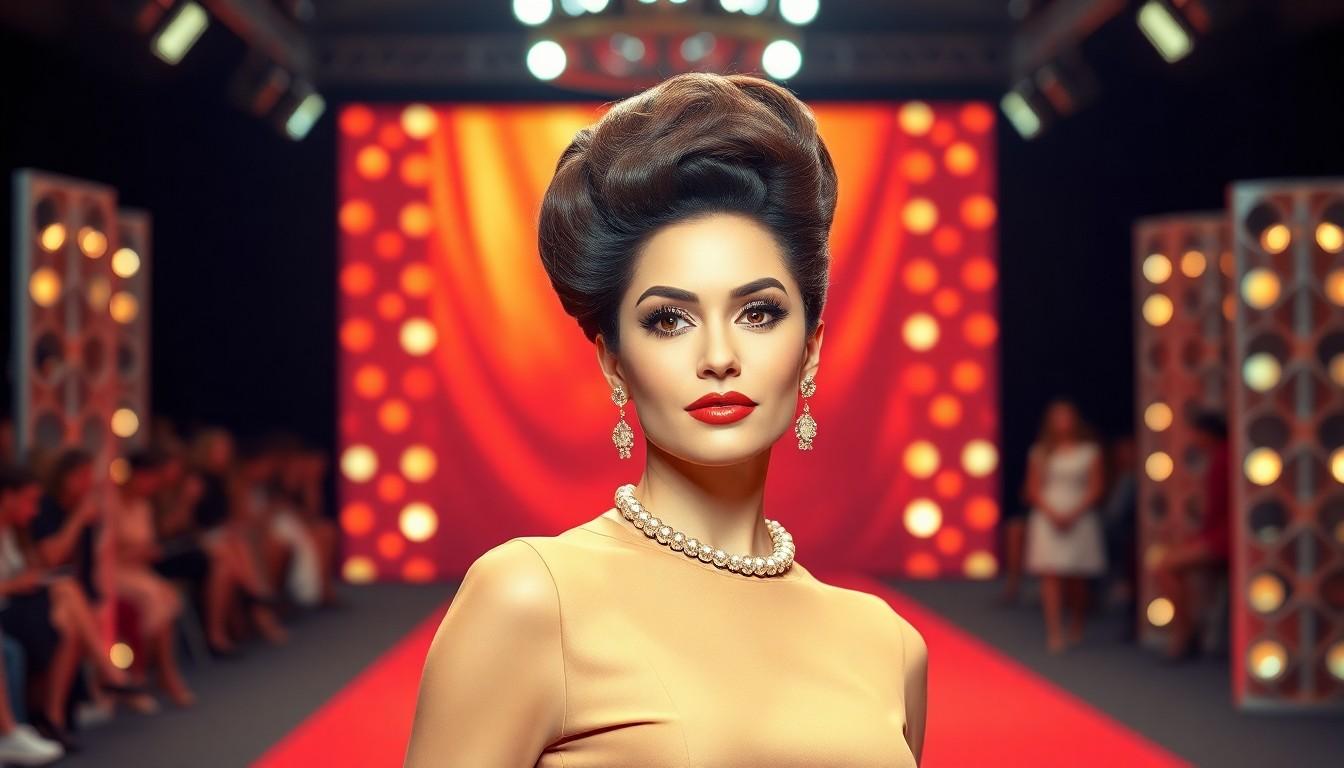
The 1960s Glamour Era
The beehive hairstyle made its grand entrance into fashion history in 1960 when Chicago stylist Margaret Vinci Heldt created this iconic updo. Fashion magazines quickly embraced the style, showcasing it as the epitome of feminine sophistication. Influential women like Audrey Hepburn, Brigitte Bardot, and Jackie Kennedy adopted the beehive, cementing its status as a symbol of elegance and poise. Their appearances on red carpets and in prestigious publications transformed the beehive from a simple hairstyle into a cultural phenomenon that defined 1960s glamour.
Revival on Modern Runways
The 2000s witnessed a important revival of the beehive on high-fashion runways, reintroducing this classic style to a new generation. Fashion designers began incorporating beehive variations in their runway shows, often adding contemporary twists to the traditional silhouette. Young women embraced this vintage-inspired look, driven by a renewed interest in retro fashion aesthetics. The style’s versatility allowed it to be adapted for various runway themes, from ultra-feminine collections to edgier, avant-garde presentations.
Celebrity-Driven Resurgence
Amy Winehouse dramatically influenced the beehive’s modern revival, making it her signature look throughout her career. The B-52’s female members Cindy Wilson and Kate Pierson also played a crucial role in keeping the beehive relevant across decades with their distinctive interpretations. Celebrity red carpet appearances featuring modernized beehives generated important media attention, inspiring countless magazine features and social media discussions. These high-profile endorsements demonstrated how this retro style could be reimagined for contemporary fashion contexts.
Television and Media Influence
The hit series “Mad Men” prominently featured the beehive hairstyle, particularly through Joan’s character, highlighting its historical significance in 1960s professional settings. This authentic representation in popular media sparked renewed interest in vintage hairstyling techniques and aesthetics. Fashion photographers began incorporating beehives in editorial shoots, often juxtaposing the classic silhouette with modern clothing and settings. These media portrayals helped educate younger audiences about the cultural importance of this iconic hairstyle.
Bridal and Formal Adaptations
Wedding runways have embraced sophisticated beehive variations, offering brides elegant alternatives to traditional updos. Fashion houses regularly showcase formal beehive interpretations during haute couture presentations, often adorned with luxury accessories and embellishments. The beehive’s structured form provides an ideal foundation for veils, tiaras, and other formal headpieces, making it a recurring choice for special occasion collections. Its ability to elevate any formal ensemble has secured its continued presence in high-fashion formal wear presentations.
Global Fashion Week Appearances
Paris Fashion Week has seen many designers referencing the beehive in collections that celebrate feminine strength and elegance. The hairstyle frequently appears in retro-themed collections at Milan and London Fashion Weeks, interpreted through various cultural and artistic lenses. Fashion photographers and street style documentarians often capture audience members sporting beehives at these prestigious events, demonstrating the style’s enduring appeal among fashion insiders. These global showcases continue to reinforce the beehive’s status as a timeless hairstyle that transcends seasonal trends.
The Cultural Impact of the Beehive Hairstyle in Popular Media
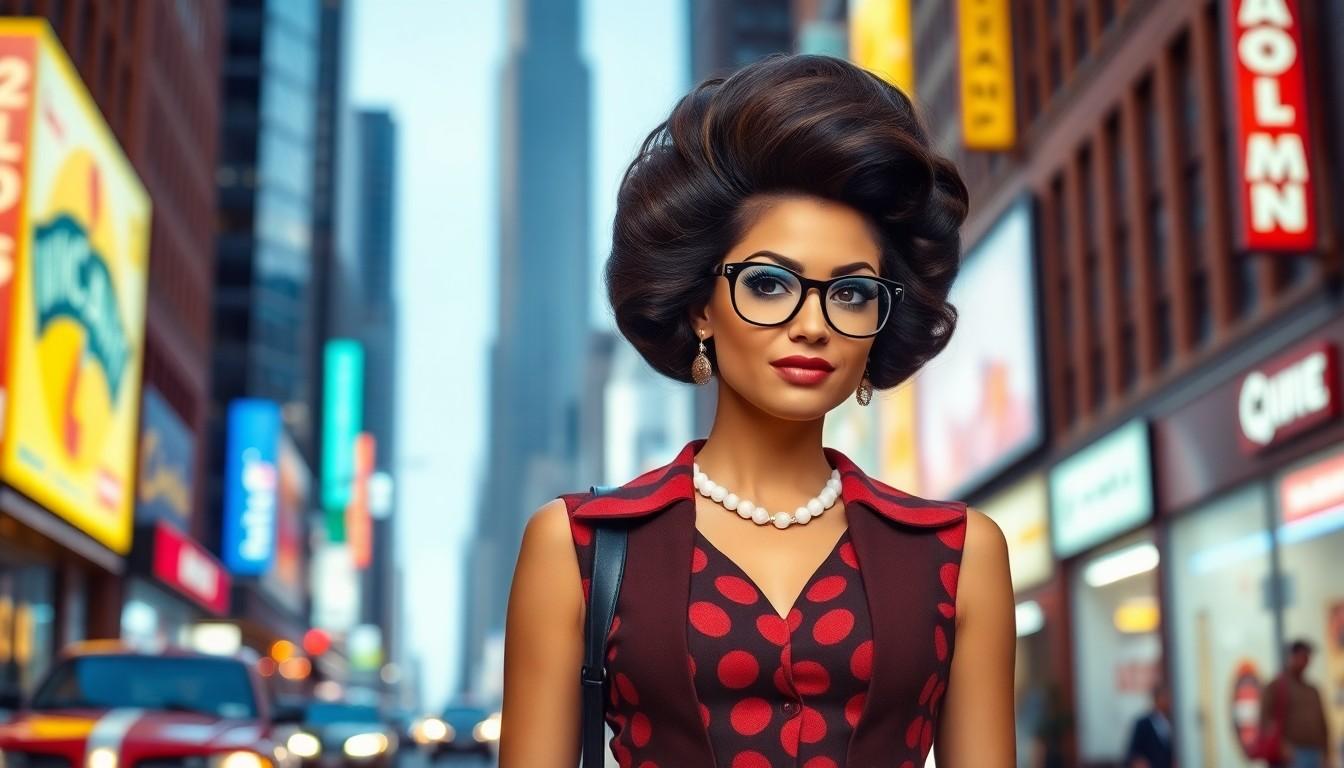
Origin and Initial Impact
The beehive hairstyle burst onto the fashion scene in 1960, created by Chicago stylist Margaret Vinci Heldt who designed it to fit perfectly under the trendy pillbox hats of the era. Her innovative creation quickly captured the imagination of fashion-forward women across America. Within months, the towering, conical style became synonymous with sophistication and modernity during the vibrant Swinging Sixties. Fashion magazines showcased the dramatic silhouette, cementing its status as a must-have look for women wanting to make a statement.
Popularization in Music and Fashion
Music groups played a crucial role in catapulting the beehive into mainstream popularity. The Ronettes, with their signature sky-high hairdos, made the beehive an essential element of 1960s girl group aesthetic. Their glamorous image influenced countless fans to adopt the dramatic style. Later, the new wave band The B-52’s embraced the retro look so completely that they named themselves after the hairstyle’s resemblance to the nose cone of the Boeing B-52 Strategic Bomber. Band members Cindy Wilson and Kate Pierson proudly sported matching beehives, bringing the vintage style to new audiences in the late 1970s and beyond.
Celebrity Influence
The 2000s witnessed a important revival of the beehive, particularly among celebrities seeking distinctive red carpet looks. A-list stars began incorporating modernized versions of the classic updo into their formal appearances. Fashion magazines celebrated this retro-inspired trend, featuring editorial spreads that showcased contemporary interpretations of the vintage style. Young women eagerly embraced these updated beehives, appreciating how the dramatic silhouette could make any outfit appear more glamorous and sophisticated.
Iconic Figures
Amy Winehouse transformed the beehive from a retro curiosity into her personal trademark. Her towering, often disheveled version of the classic style became inseparable from her public image and musical persona. Interestingly, Winehouse’s signature look began as a joke when her hairdresser created an exaggerated beehive for fun. The singer immediately connected with the dramatic style, making it her own and elevating it to iconic status. Through her influence, the beehive gained new cultural significance as a symbol of retro-cool and artistic individuality.
Enduring Symbolism
The beehive continues to represent 1960s kitsch and glamour in our collective cultural consciousness. Fashion designers regularly reference the style in runway collections that celebrate mid-century aesthetics. Music videos frequently incorporate beehive hairstyles when artists want to evoke a sense of retro glamour or theatrical excess. The distinctive shape remains instantly recognizable across generations, transcending its original context to represent a timeless form of feminine extravagance.
Cultural References
Throughout popular media, the beehive appears as visual shorthand for exact character traits and time periods. Films set in the 1960s often use the hairstyle to establish period authenticity and character status. Television shows like “Mad Men” have featured the beehive to signal a character’s fashion-forward sensibilities. The elaborate process of creating the style—teasing and backcombing hair to impressive heights—has been depicted in countless beauty tutorials and makeover sequences. Through these varied appearances, the beehive maintains its position as one of the most recognizable and culturally important hairstyles in modern history.
Conclusion: Why the Beehive Hairstyle Continues to Endure
The beehive hairstyle’s remarkable journey from 1960s salons to today’s runways proves its timeless appeal. What began as Margaret Vinci Heldt’s creative vision has transformed into a cultural touchstone that adapts to changing trends while maintaining its distinctive silhouette.
Whether you’re drawn to its vintage glamour or its modern interpretations we’ve explored, the beehive offers versatility few other styles can match. It’s more than just a hairstyle—it’s a statement of confidence and sophistication that transcends generations.
As fashion continues to evolve, the beehive remains a powerful reminder that true style never truly fades—it simply reinvents itself for new admirers to discover.
Frequently Asked Questions
Who invented the beehive hairstyle?
The beehive hairstyle was created in 1960 by Chicago-based hairstylist Margaret Vinci Heldt. She developed the cone-shaped updo for a magazine feature that requested a new and exciting style. The hairstyle quickly gained popularity among sophisticated women and celebrities, becoming one of the defining looks of the 1960s.
Why is the beehive hairstyle still popular today?
The beehive remains popular because of its timeless elegance and versatility. Its ability to evolve with modern interpretations while maintaining its classic silhouette appeals to fashion enthusiasts. The style has been continuously reinvented by celebrities and designers, making it relevant across generations. Its association with glamour and sophistication gives it staying power beyond seasonal trends.
How do you create a basic beehive hairstyle?
To create a basic beehive: 1) Tease the crown section of your hair for volume, 2) Smooth the outer layer of hair over the teased section, 3) Gather hair at the back, 4) Secure with pins in a cone shape, 5) Finish with hairspray. The height can be adjusted based on preference, from subtle elevation to dramatic height.
Which celebrities are known for wearing beehive hairstyles?
Several iconic celebrities have worn memorable beehive styles, including Audrey Hepburn in “Breakfast at Tiffany’s,” Brigitte Bardot, and Jackie Kennedy in the 1960s. In more recent times, Amy Winehouse made the beehive her signature look with a modernized, exaggerated version. Other celebrities like Adele, Beyoncé, and Katy Perry have worn updated interpretations for red carpet events.
Can you do a beehive with short hair?
Yes, you can create a beehive with shorter hair, though the result will be more modest in height. For hair above shoulder length, focus on creating volume at the crown through teasing and use bobby pins to secure the style. Hair accessories, small hair donut forms, or partial extensions can help achieve the silhouette with shorter lengths.
How do you modernize a beehive hairstyle?
Modernize a beehive by incorporating softer textures and casual elements. Try a “messy beehive” with loose tendrils framing the face, combine it with braids, or create a half-up beehive. Using lightweight styling products prevents the stiff appearance associated with traditional beehives. Contemporary interpretations often feature less dramatic height and pair well with casual outfits.
What styling products are best for a beehive?
The best products for a beehive include volumizing mousse or spray applied to damp hair before blow-drying, texturizing powder or dry shampoo at the roots for grip and volume, and a medium-hold hairspray that offers structure without stiffness. A teasing comb, fine-tooth comb for smoothing, and quality bobby pins are essential tools for creating and maintaining the style.
Is the beehive suitable for formal occasions?
Absolutely! The beehive is perfect for formal occasions like weddings, galas, and special events. Its elegant structure complements formal attire and creates a sophisticated silhouette. For weddings, softer beehive variations work beautifully with veils and tiaras. The style’s height adds drama and photographs well from all angles, making it a favorite for red carpet events.
How long does it take to create a beehive hairstyle?
Creating a beehive typically takes 15-30 minutes depending on hair length, thickness, and your experience level. Beginners might need 45 minutes initially. The process involves teasing for volume, smoothing the outer layer, shaping the cone structure, and securing with pins. With practice, the styling time decreases significantly. For special events, allow extra time for perfecting the shape.
What cultural impact has the beehive had?
The beehive has had significant cultural impact since the 1960s. It symbolized the changing role of women during that era and became associated with sophistication and glamour. Music groups like The Ronettes and The B-52’s (who named themselves after the hairstyle) helped popularize it. The style appears in numerous films and TV shows as visual shorthand for specific time periods or character traits.


